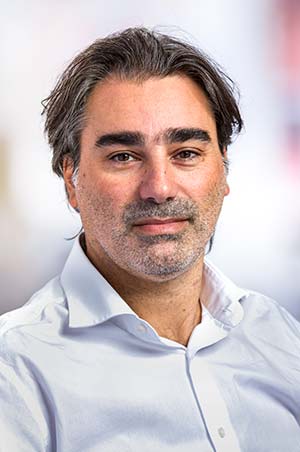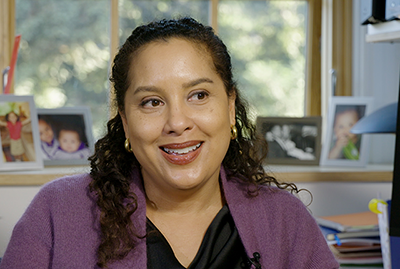

Cord blood transplant saved woman from rare cancer
Alexes Harris’ spin classes were starting to feel impossible. During the 20 seconds on and off sprints, she would become breathless.
“I used to always be able to do them, but in 2015 during these exercises, I’d find myself out of breath, as if I was having an asthma attack,” she said. At the time, however, Harris was a fit 41-year-old with no history of asthma.
Her doctor suggested it might be adult-onset asthma, but also prescribed a routine blood panel. The tests showed a low white blood count, which the doctor said she should monitor. Then Harris started to feel fatigued. Then dizzy. Then bruises started to appear.

Frustrated by clinicians whose ongoing counsel was to “wait and see,” Harris, a University of Washington sociology professor, switched to the UW Medicine-Fred Hutch system to get a second opinion. A UW Medicine hematologist suggested she undergo a bone marrow biopsy “so we could just rule out blood cancer,” Harris recalled.
The tissue biopsy was taken on a Wednesday in May 2016. On Thursday, the doctor called back and said it was serious. Harris was diagnosed with a rare blood cancer known as myelodysplastic syndromes, or MDS. She and her husband listened in shock as the doctor said that, without treatment, she had 18 to 24 months to live.
Of course, cancer wasn’t part of her plan. Harris was a happily married mother of two children, 5 and 8 years old. Her new book was in the publication pipeline.
So, she started aggressive chemotherapy at UW Medical Center-Montlake in June. Initially it pushed the cancer into remission, but when the disease reemerged, her team explored a bone marrow transplant.
A database search showed two potential matches, but both people declined to engage in further testing. She had no viable matches, not even with her twin brother. Ironically, her own bone marrow turned up as a possible match; decades earlier, Harris had registered for the “Be the Match” bone marrow registry while she was a student at UW.
“It was like my 20-year-old self was trying to save my 40-year-old self,” she said.
For Harris, whose father was Black and Filipino, and her mother, who was white, finding a match was a challenge.
"We are so underrepresented on the bone-marrow registry. Being African American, Asian American, Native American, Latinx — and then if you have any intersections of those identities, we have a very low likelihood of finding matches, something like 20 to 30%," she said.
Aside from blood types, human leukocyte antigen (HLA) typing is used to match patients and donors for bone marrow or cord blood transplants. HLA are proteins -- or markers -- found on most cells in your body. Your immune system uses these markers to recognize which cells belong in your body and which do not.
Because of HLA-typing, a patient needing a transplant is more likely to find a match from someone who shares the same racial or ethnic background. Currently, Black patients only have a 29% chance of finding the perfect match, while white European patients have a 79% chance, according to a Bloodworks Northwest researcher.

One clinician on her team, Dr. Filippo Milano, suggested an alternative: a transplant using stem cells obtained from umbilical cord blood. He was running a trial involving cord blood transplantation at the Fred Hutchinson Cancer Center, and the results had so far shown “very similar to a 100% match,” Harris recalled.
In September of 2016, Harris received a cord-blood transfusion at UW Medical Center. About three weeks later, the transplant was deemed a success. A biopsy that December showed no sign of cancer.
“The donated cord blood from the baby girl saved my life,” Harris said. “It was an amazing experience to know that, on the first day of her life, this baby saved mine because of this donation.”
This fall, UW Medical Center-Montlake restarted its cord-blood donation program in partnership with Bloodworks Northwest. The OB-GYN team hopes more moms will donate cord blood, which is otherwise discarded as medical waste, said Dr. Sarah Prager.
Cord blood is collected from the umbilical cord removed from a newborn. The blood is tested and cryogenically stored to preserve the stem cells, Prager explained. Those cells can be used to treat dozens of conditions such as blood disorders and leukemia.
“What better way to start your baby’s life than saving someone else’s?”
The pluripotent, or undifferentiated, cell properties of the blood means it can be used in bone marrow transplants even if the baby’s blood type doesn’t match the recipient’s.
Harris hopes more mothers will consider donating their baby’s cord blood.
Harris also encourages other BIPOC community members to register in the national bone marrow registry.
Her priorities have changed over the past seven years. She focuses on her kids (now teens), her husband and other relationships. She still keeps in shape, is back to indoor cycling classes, and has signed up for the Big Climb, a 69-floor, 1,311-stair walk in March 2024 to raise money for the Leukemia and Lymphoma Society.
“Things are good. And I’m so thankful.”